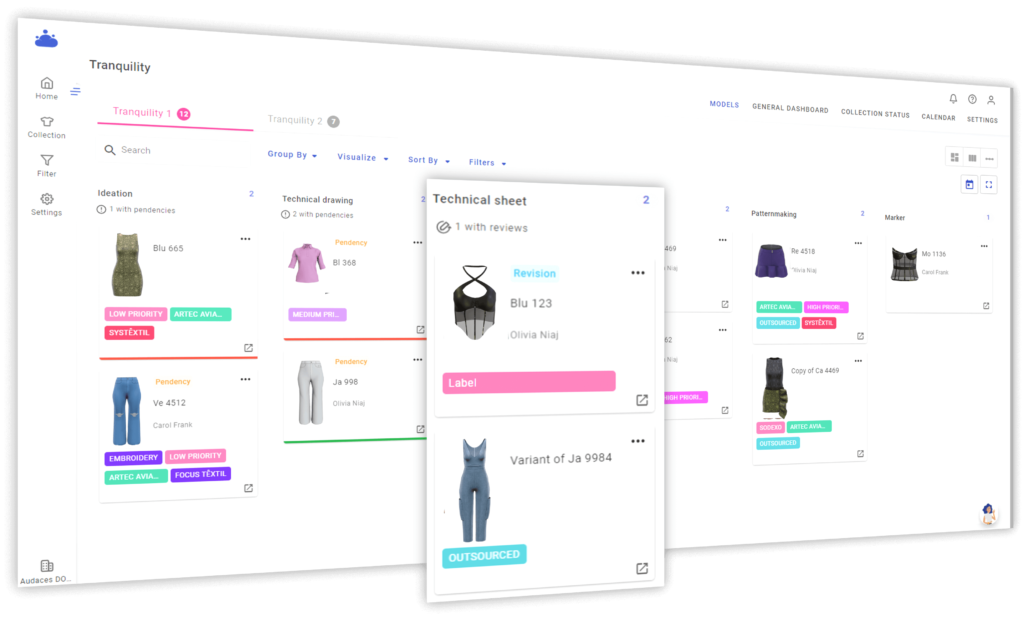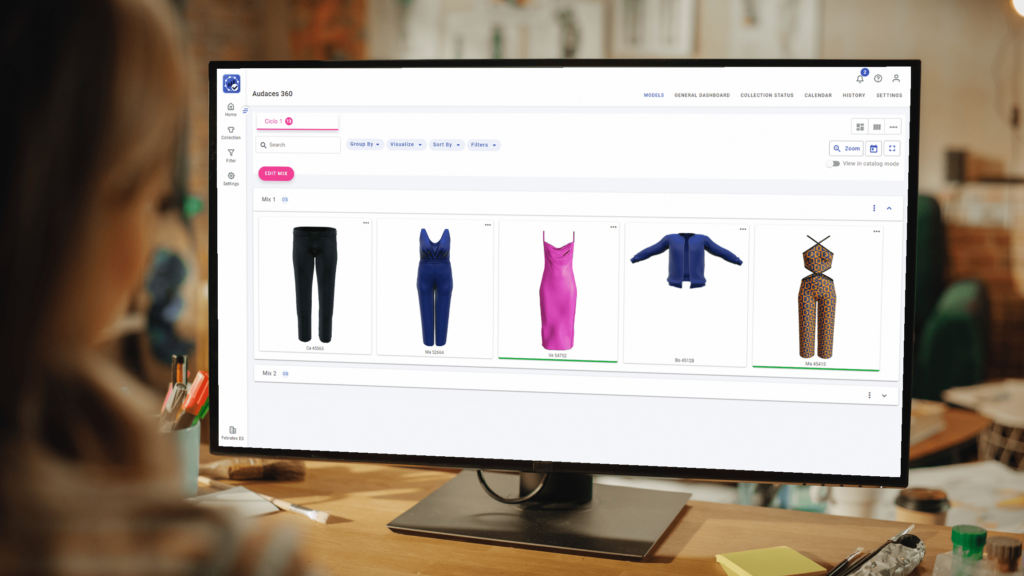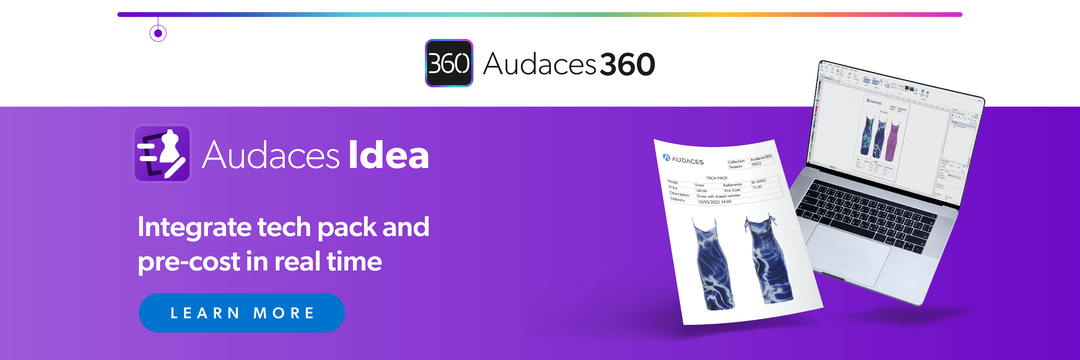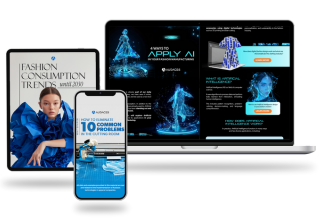Summary
- A digital product passport (DPP) is a digital record that tracks a product through its lifecycle.
- By offering customers proof of sustainability and traceability, it brings a unique selling point for brands.
- Stand out in the fashion world with Audaces360 technology. Start your free trial now!
In the fashion world, a growing number of brands are embracing a new tool: the digital product passport (DPP). Acting like a digital identity card for each garment, a DPP carries key information, from origin to repair.
This innovation comes directly from the EU’s Ecodesign for Sustainable Products Regulation (ESPR). It aims to make product transparency mandatory for apparel, footwear, electronics, and more.
By 2027 or 2030 (depending on the category), brands selling in the European Union must include DPPs. That’s why we’ll dive into how a digital product passport works and what steps you can take to prepare.
Happy reading!
Sumário
What is a digital product passport?
A digital product passport (DPP) is an online ID card for products. It gathers important product data that tells the story of where something comes from. This information is available digitally and you can share it easily with anyone.
To make it simple to access, each product usually comes with a QR code. When scanned, this code opens a page with details about the product’s origin, materials, and even how to care for it. This makes it easier for people to understand what they are buying and how to use or recycle it properly.
The goal of the digital product passport is enhancing transparency. Brands can show how they can make their products and what impact they have on the environment.
By using a DPP, companies can also improve their supply chain management. It keeps everyone in the process — from suppliers to customers — connected and informed.
How does the digital product passport work in fashion?
In the fashion industry, the digital product passport starts with material sourcing. Brands record where fabrics and materials come from and what certifications they hold.
As the garment moves through design, production, and shipping, more information becomes available. This could include data on manufacturing methods, dyes, and packaging.
When someone buys the product, they can scan the QR code to see this history. People can learn how to care for their clothes, where to repair them, and eventually how to recycle them. It supports a more circular fashion economy by keeping products in use for longer.
The digital product passport also helps brands ensure compliance with new laws and standards.
Many countries are making rules to encourage sustainability and reduce waste. Having clear, up-to-date product data helps brands meet these requirements and avoid penalties.
Learn more: Explore the fashion future demands and anticipate what’s next in the market
What does the digital product passport record?

Resources and raw materials
The digital product passport keeps track of all the resources and raw materials used to make an item. It includes fabrics, buttons, threads, and any other parts that go into the final product.
Knowing the materials used helps measure the environmental impact of each product. It shows how much water, energy, or chemicals were necessary and what effects they might have on nature.
For customers, this data offers clarity. People can see whether the materials come from recycled, organic, or certified sources. It helps them choose products that match their values and care about the planet.
Origin
The passport records where each part of a product including fabric, trims, or labels comes from. This information covers countries of origin, suppliers, and even farms or factories if available.
It also keeps a record of the model batch. This shows when and where the company produced the item and connects it to other items made at the same time.
Another key detail stored is the material composition. It specifies the percentage of cotton, polyester, elastane, or other fibers the product might contain.
Processes
The DPP also keeps a record of processes used in making the product. This includes cutting, dyeing, sewing, finishing, and packaging.
Recording these stages helps prove that the product underwent processes that followed safety and quality standards. It also helps brands show whether they used energy-efficient or eco-friendly production methods.
Customers get to see what happens behind the scenes. It helps them value the work that goes into each piece and understand why it costs what it does.
For companies, having this data also makes it easier to review and improve processes. You can identify where waste or mistakes happen and find better solutions.
Learn more: Smart uses of clean technology in clothing manufacturing
Maintenance or repairs
This is the part that offers tips on maintenance or repairs. The goal is to help people take better care of their clothes, so they last longer.
It might suggest the best way to wash, dry, or iron a garment to keep it in good shape. This way, consumers can prevent damage and keep colors and fabrics looking fresh.
For repairs, the passport guides customers on replacing buttons, fixing seams, or patching fabric. Some brands even add links to tutorials or partner repair services.
Recycling and disposal
Finally, the digital product passport explains how to recycle or safely dispose of an item. This supports a circular economy by keeping materials in use.
It may list recycling centers, take-back programs, or special steps needed to separate different materials. For example, removing a metal zipper before recycling fabric.
This information makes it easier for customers to do the right thing. It also shows that the brand cares about what happens to products after sales.
In the long term, it reduces landfill waste and protects natural resources, making fashion more sustainable.
Worried about implementing new technology in your production? Don’t be! Discover how to do it smoothly while keeping your operations running. Download our resource to learn more!
Which sectors are already using the DPP in the fashion industry?
These are some fashion sectors that already benefit from the digital product passport:
- Luxury brands: Using digital product passports to prove authenticity and trace high-value materials.
- Sustainable fashion labels: Adding data about recycled fibers, organic cotton, and eco-friendly dyes to show their environmental impact and commitment to responsible production.
- Sportswear manufacturers: Tracking material sourcing and production processes to ensure compliance with safety standards and to highlight performance technologies.
- Denim and jeans makers: Recording water usage, washing processes, and chemical treatments.
- Fast fashion companies testing circular models: Including care, repair, and recycling instructions.
- E-commerce platforms: Customers can instantly access product origin, materials, and sustainability data before buying.
Learn more: Discover the current landscape of the fashion market and how to stay competitive
Benefits of adopting the digital product passport in your business

Full transparency for consumers and partners
Being open about your processes builds trust between brands, consumers, and supply chain partners. Everyone can check the same product data, which makes it easier to spot problems and fix them quickly.
When people know more about the products they buy, they feel more confident in their choices. Over time, this level of honesty can help businesses stand out in a crowded market.
Enhanced brand reputation
A brand that shares complete information about its products often earns respect from consumers and industry partners. Showing a real commitment to transparency makes the brand appear responsible and forward-thinking.
Digital product passports also make it easier to prove claims about sustainability, fair labor, and quality. Instead of vague promises, businesses can present facts backed by data.
This stronger reputation can attract new customers who care about ethical practices. It also strengthens loyalty among existing buyers.
Learn more: How to master sustainable creation and production in the eco fashion era
Easier recycling, repair, and reverse logistics
A digital product passport stores detailed information about materials, design, and care instructions. This makes it much easier for recycling centers or repair shops to handle items correctly.
It also encourages consumers to choose repair over replacement, which extends the product’s life.
Meanwhile, simpler reverse logistics, which means getting items back for recycling or reuse, can cut costs. It can open new revenue streams, like resale or refurbished collections.
Alignment with regulations
More countries are starting to require brands to share detailed product information, especially around sustainability and sourcing. Digital product passports make it easier to meet these new laws.
Having the right data ready helps avoid fines and keeps products on the market without delays. It also shows that the brand is proactive and prepared for changes in the industry.
Learn more: Why consider sustainable consumption and production for your company?
How to implement a digital product passport using technology?
Implementing a digital product passport starts with organizing and collecting the right product data. Brands need to gather detailed information on materials, production steps, and design decisions from the very beginning of development.
Technology plays a key role in making this process smooth and efficient. Using a PLM (Product Lifecycle Management) platform, businesses can manage all data related to their products in one place. This includes material composition, design files, tech packs, and supplier details.
As a result, brands can build digital product passports with accurate and complete data straight from their daily workflow.
Once the data is ready, technology can link it to a unique QR code or digital tag attached to each product. It’s simpler for consumers and partners to access all product details anytime, supporting transparency and better decision-making.
Learn more: Discover PLM and its benefits for fashion manufacturing
Manage every product stage with fashion PLM Audaces Isa

Streamline your workflow, accelerate production, and elevate your brand with Audaces Isa.
This innovative solution empowers fashion companies to take control of their entire collection development process. From initial ideas to final products.
Audaces Isa centralizes data and fosters collaboration, leading to more than 30% reduction in product launch time. You can even have real-time access to your collection’s progress directly from your phone, with the mobile version.
Identify potential issues early, track progress seamlessly, and enable teams to optimize production and quality.
Discover Audaces360 and unlock a world of possibilities for fashion design and production. Explore our comprehensive suite of solutions today!
FAQ
A digital product passport (DPP) is an online ID card for products. It gathers important product data that tells the story of where something comes from. This information is available digitally and you can share it easily with anyone.
In the fashion industry, the digital product passport starts with material sourcing. Brands record where fabrics and materials come from and what certifications they hold.
A digital product passport includes information of raw materials, origin, processes, maintenance, and recycling or disposal.










